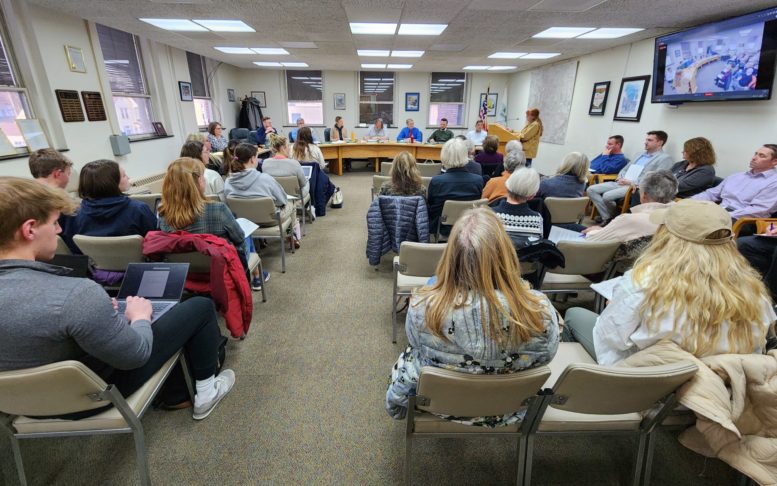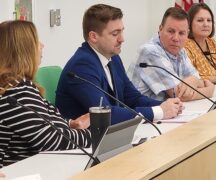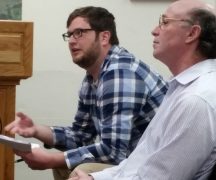By JAN LARSON McLAUGHLIN
BG Independent News
Bowling Green residents made another pitch Monday to protect their neighborhoods and downtown from threats they see in the city’s zoning code update.
Sandy Wicks spoke in defense of downtown businesses and of people living in rental housing.
The proposed Pedestrian Residential zoning in the neighborhoods bordering the downtown would allow for some businesses in residential areas, and allow for more single-family homes to be divided into rentals, the opponents have said.
Wicks said homeowners in these neighborhoods aren’t against renters – but they are concerned about the condition of many rental units in the city.
“It’s the renters we want to protect – so the people renting these homes don’t live in substandard homes,” she said.
Wicks also contested the claim that the Pedestrian Residential zoning would make the neighborhoods more “walkable.” The blocks adjacent to Main Street, from Poe to Napoleon roads, are already very walkable, she said.
Allowing small businesses to set up shop in the residential areas will threaten the vibrant downtown area, said Wicks, who founded Grounds for Thought and has a soft spot for the downtown.
Wicks said she recently conducted a “windshield survey” of the downtown area of Main Street between Clay and Lehman avenues. She counted 14 empty storefronts and at least 30 vacant office spaces.
To remain robust, the downtown needs customers to visit there – not be drawn to competition in neighborhoods, where homeowners don’t want them, she said.
“What we need to focus on is maintaining the neighborhoods and supporting downtown,” Wicks said.
Jeanine Alberti, who lives in the proposed Pedestrian Residential zoning area, said she is a big supporter of downtown businesses.
“But we do not want to have a business next door,” she said.
Alberti said she also dreads the thought of more multi-family dwellings and increased density “in our little neighborhood.”

Rose Hess questioned the city ordinance language defining the number of occupants that can reside in a home. As a member of the East Side Neighborhood organization, Hess and others visit about 500 rental units every fall when BGSU students return to school. The new language is far too confusing for students – and others – to understand, she said. The city’s website mentions future occupancy will be based on the number of bedrooms.
“If that’s the case, say it,” she said. “Say ‘one per bedroom,’ then everyone will understand.”
Hess also talked about the number of non-conforming properties in BG – citing 260 by her count that are being used for purposes other than what they were zoned for.
Joyce Kepke said there are more than 260 non-conforming properties, with many single-family homes being illegally split into multi-family rentals. While 65% of the city’s housing units are rentals, a higher percentage of rentals (77%) make up the proposed Pedestrian Residential areas, she said.
“The Pedestrian Residential district already has its share,” she said.
Kepke suggested the city is nearing a “tipping point,” with the lack of affordable homes for middle income families becoming a huge problem.
“Are we not concerned?” she asked. Will tenants be as invested in the community and support the schools, the parks and the downtown, Kepke asked.
Marilyn Shrude told City Council that the Save Our BG Neighborhoods Committee is looking forward to Thursday’s meeting devoted to hearing more from residents about the zoning update.
“We view this as an opportunity for open dialogue,” Shrude said “You have listened patiently to our concerns, but we still aren’t sure what you are thinking.”
Both City Council and the citizens are seeking a positive solution, she said.
But Faith Elsea didn’t seem to share that optimism.
“Why is council determined to build more duplexes?” she asked.
“We the people, we want to do what we can to preserve our land, our homes and our heritage,” Elsea said.
Council President Mark Hollenbaugh reminded citizens of the zoning meeting set for Thursday at 6 p.m., in the Veterans Building in City Park. The meeting is intended to give the community another opportunity to express their feelings about the proposed zoning code update.
The meeting will begin with brief presentations on the three options that have been mentioned for the residential blocks that surround the downtown area. Those options include the original proposal for Pedestrian Residential zoning, the citizen proposal for a Central Resident District, and the third alternative dubbed the Phipps-Dennis Plan.
The meeting will then break into small group roundtable discussions.
The next zoning meeting will then be held on March 27, also at 6 p.m., in the Veterans Building. During that meeting, council members will discuss items they would like put in or taken out of the zoning update.
In other business at Monday’s meeting:
- Chris Mowen, of the city’s Historic Preservation Commission, talked about the recognition of historic properties in the city during National Preservation Month in May. People with historic homes or businesses may apply for a “History Lives Here” sign on the city’s website.
- East Side resident Rose Hess thanked the city for funding a study for the hike-bike trail from Crim Elementary to Carter Park. City Public Services Director Joe Fawcett said the Mannik & Smith study will also look into possible funding for the project.
- Mayor Mike Aspacher reported that Bowling Green has once again been named a Tree City USA, plus earned a “growth award.”
- Council set a public hearing for May 1, at 6:30 p.m., for the rezoning request for 37 acres in the southwest corner of Newton Road and Brim Road, from M-3 business park zoning to R-2 single-family zoning.
- Council voted to authorize the city to enter into contracts related to financial matters, construction, infrastructure, right-of-way acquisition, and improvements for the Abbott Laboratories project on Ohio 25.





